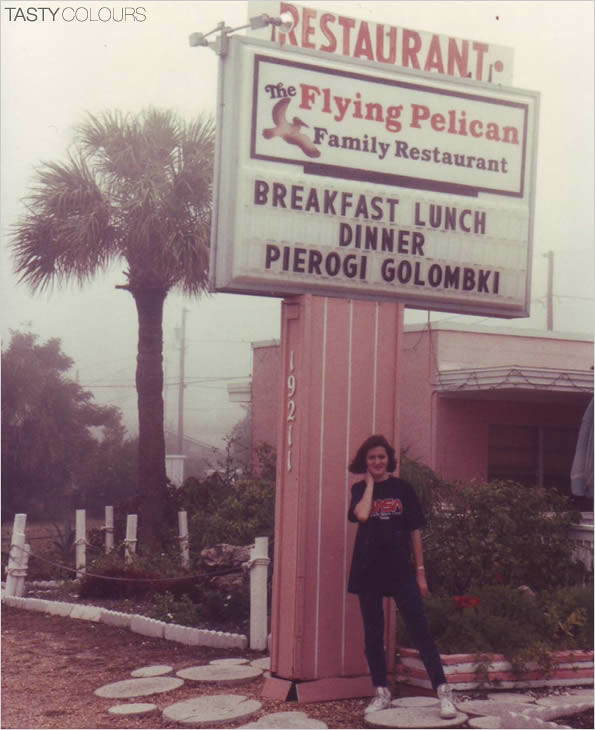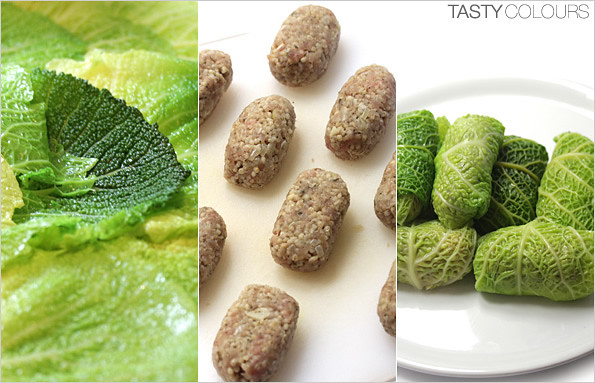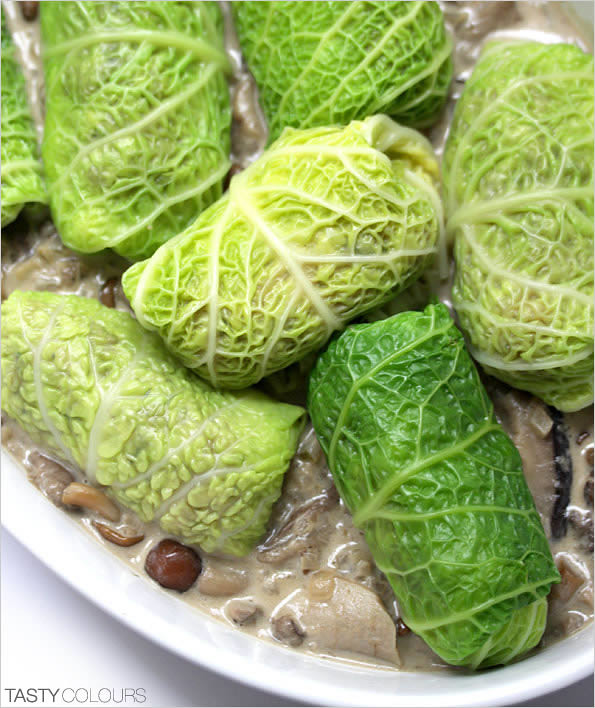My
engagement into professional life did not allow for posting for a long while. I
know, I know I should have warned you! I am extremely sorry for that. I am timidly
coming back to you with another Polish classical dish – cabbage rolls named “gołąbki”.
The
picture that you can see below was shot by my father in December 1989, in
Florida. The young girl that you can see on that picture, well that’s me, when
I was 15. I could not resist publishing it tonight. It was my first trip not
only to the U.S., but to the Western World – straight from a grey (but
allegedly the funniest) communist country.
I can remember – and if I am wrong I am sure that my father will correct
me after reading this post – that when we were on the highway in Florida, we
suddenly stopped over because we had noticed a small restaurant building with a
Polish signage (which was rather not so common at that time in Florida and
probably still is not nowadays), close to a city called St. Petersburg (but not
in Russia). We stopped there because we noticed the names of the most common
Polish dishes – “pierogi” (dumplings),
and “golombki” (cabbage rolls).
Unfortunately, the restaurant was closed.
The literal translation of the dish means “little pigeons”. But it has nothing to
do with those birds which I hate by the way (because they shit all over and
they wake me up at 5 o’clock in the morning). Those cylindrical cabbage rolls
are usually stuffed with meat, rice, kasha oraz mushrooms etc. Then they are
baked in the oven or slowly cooked in a heavy pot (depending on family
traditions). The origins of the name “gołąbki” are not quite clear. I only
found out that in Slavic languages and culture, names of animals and birds had
been frequently used to name breads and meals, in particular ritual ones. The
name “gołąbki” was probably taken from the Ukrainian language.
From the
technical point of view, the rolls are more time consuming than difficult to
prepare. Probably that is why they were not cooked on a regular basis in my
home. Although my mother claims that she used to prepare “gołąbki” regularly, I
swear that I cannot recall of that.
It is
actually surprising that such a time consuming preparation (the same applies to
“pierogi”) were and still are a popular dish in all canteens, cheap bars and
family restaurants. There, the most common version goes with pork, rice and
tomato sauce. The version that I can remember from my school canteen was awful;
the cabbage leaves in which the stuffing was rolled were always too hard. On
the contrary, the rice and meat stuffing was overcooked. The tomato sauce was
made from concentrate and it was very thick due to the great amount of
thickeners like flour, for example, that was used.
I changed
my mind towards “gołąbki” thanks to a friend of my mum’s, as it was one of her
flag dishes. Hers were different. She never used white cabbage leaves. Instead,
she preferred the more delicate savoy cabbage. She was stuffing them with rice
and soaked, dried forest mushrooms (as most people in Poland do not eat meat
for Christmas Eve dinner). But even though, a good few years had to pass before
I made my first cabbage rolls. I was always scared to blanch the cabbage leaves
in boiling water – it looked like a horrible job to me.
Of course,
one can use regular white cabbage leaves to make “gołąbki”. I think however
that savoy cabbage is better – it has thinner leaves and tastes better once
cooked. You can also experiment with red cabbage leaves. In the recipe
presented in this post I used pork meat (or you can use your favorite). Rustic
and old fashioned versions include mashed potatoes and onions (as “ruskie pierogi”), as well as forest mushrooms.
Some
people (like me) bake those rolls in the oven; some simmer them slowly in a
“cocotte”. Irrespective of the method you use, you will need some liquid
(vegetable, meat or mushroom broth or for example, my latest discovery –
“żurek” – this I learnt recently from my father who himself learnt it
from his mother). You also need a large, deep pan with a thick bottom.
Usually
the rolls are stuffed with rice. But traditional recipes call for authentic
Polish grains – for example barley, or buckwheat. You may serve your gołąbki
sauté, just like this, cooked in their own juices. However, I believe that in
Poland the most popular way to serve them is with tomato or mushroom sauce.
In the
past a rustic version of this common food was also made from the leaves of
pickled cabbage (the cabbage was pickled in whole). Nowadays, you will not find
this version in Poland (but I’ve heard that one can find it in stores selling
Russian food in New York).
Note that
I could not resist photographing them before baking them, when the green colour
of the leaves looks so nice and inevitably fades away after baking.
Serves 4 (8-14) cabbage rolls depending on
the size of cabbage leaves
Ingredients:
For the rolls:
1 savoy cabbage (around 1.3 kg)
350 g ground pork (you can use your preferred
meat; for a vegetarian version use around 500 g of mushrooms – you must sauté
them beforehand)
100 g kasha (for example buckwheat or barley)
1 teaspoon
marjoram, preferably fresh
800 ml to
1l broth (meat, mushroom or vegetable)
1 big yellow onion, peeled, washed and finely
chopped
2 garlic cloves, peeled and finely
chopped
2
tablespoons butter
3-4
tablespoons goose grease (or
vegetable oil)
Salt
Pepper
For the
tomato – vegetable sauce:
600 g ripe
tomatoes, blanched, peeled and
seeded; cut into quarters (optionally, use canned tomatoes)
2 garlic cloves, peeled and finely
chopped
1 onion, peeled, washed and finely
chopped
1 medium carrot, peeled, washed and very finely
chopped
¼ small celery root (around 100 g); peeled and
washed, very finely chopped
100 ml dry white wine
200 to 250
ml broth (use the one prepared for the rolls above)
1
tablespoon chopped parsley
½ teaspoon
sweet powdered paprika
3
tablespoons olive oil
Salt
Pepper
Sugar
For the mushroom sauce:
450 g forest mushrooms (ceps, boletus, chanterelles)
– fresh or frozen
1 large yellow onion, peeled and finely chopped
Around 150
ml meat or vegetable broth
100 ml sour cream
Salt
Pepper
For “sauté style” in żurek (then you do not
use the meat or vegetable broth as indicated above)
500 ml żurek (recipe HERE)
4 to 5 g dried forest mushrooms
Kasha preparation:
1. Place
kasha into strainer and rinse under running water. In a hot saucepan with a
thick bottom, melt goose grease (or vegetable oil).
2. Add
grains and fry, mixing constantly, around 3 to 4 minutes (until grains become a
bit transparent).
3. Add the
same volume of liquid (broth) and cook under cover, over a low flame, until the
stock is completely absorbed. I prefer when kasha is half cooked. Then it will not be totally overcooked after
baking your gołąbki in the oven.
Put aside.
Preparation of cabbage rolls:
1. Take a
big pot (I use a 10 liter pot) and boil around 6 to 7 l of water with some
salt. Keep it simmering.
2. Remove
external leaves of the cabbage. Throw away those which are rotten. Put aside
those which are just too thick and too hard – you will need them later on.
3. Using a
sharp knife, delicately start to core the cabbage. The goal is to separate the
leaves one by one without damaging them. You will find detailed instructions on
how to core the cabbage on http://www.ehow.com/how_2087524_core-cabbage.html. Choose
the largest and nicest ones (you will need about 14 of them) to make the rolls.
Put aside the smallest ones – you will need them later on.
4. Place
cabbage leaves in batches of around 3 or 4 into boiling water and blanch them a
couple of minutes. They have to soften a bit but should still retain their
vivid green color. Do not put them at once because you can break the leaves.
Place the blanched leaves on a round, flat plate, let them cool down because
now you have to remove delicately the central “nerve” from each of the leaves,
so they can roll nicely and evenly.
5. Take a
frying pan. Heat it well and melt the goose grease (or oil). Add onion, fry
over medium flame mixing constantly for around 10 minutes until it is cooked
(onion needs time to cook). Add garlic and sauté for another couple of minutes.
6. Take a
large bowl. Mix pre-cooked kasha, meat, fried onions with garlic, marjoram,
salt, pepper and make it homogenous.
7. Divide
the stuffing into equal parts and form them into cylinders. I am not “gołąbki”
master, I usually count the number of leaves, check the size of them and I
divide the stuffing according to the size of the leaves. Place each cylinder in
the center of a cabbage leave (usually around 60 g of stuffing). Fold the bottom edge of the leaf up and away from you.
Fold in the sides and roll as for spring rolls.
8. In the
meantime, heat the oven to around 180 degrees Celsius. Roughly chop the
remaining cabbage leaves (those which you put aside earlier on) and place them
in the bottom of the pan (they will prevent the rolls from burning). Then place
the cabbage rolls in layers, quite tightly (they will shrink during baking).
Now pour some broth, add a few strips of butter and place the rest of the
cabbage leaves on top. Bake in the oven for at least 2 hours. If the liquid
evaporated, add some more.
Serve with
either: baking juices, tomato sauce or mushroom sauce.
This is a
type of food which tastes even better on the next day.
Tomato - vegetable sauce
1. Pour
olive oil into a hot frying pan. Wait until hot, add
onion and fry over a small flame for around 10 minutes, mixing often and being
careful not to burn it. Add garlic and fry for a couple of minutes, mixing.
2. Then
add carrot, celery root and simmer for 10 minutes. If necessary, pour a bit of
vegetable stock. Add tomatoes and cook for another 30 minutes over a low flame,
mixing from time to time. If necessary, add some vegetable stock so the sauce
is not too thick.
3. After
15 minutes, add white wine and reduce the sauce. Add salt, pepper, paprika and
if necessary, a bit of sugar and cook for another 5 minutes. Blend the sauce
(although this is not an obligation).
Mushroom sauce:
1. Clean
mushrooms from forest leftovers. Slice them into equal parts (if necessary).
2. Heat
well the frying pan, add olive oil, onion and fry over medium heat, mixing
constantly.
3. Once
the onion is nicely cooked, add mushrooms. Fry them for a few minutes over
maximum heat until the juice is evaporated. Then add some broth (vegetable,
meat or whatever you have) and cook for another 10 minutes, until the juice is
reduced and thick.
4. Add
cream, season with salt and pepper according to your taste. Sprinkle with fresh
parsley (optional) before serving.
“Sauté style” in żurek
1. In a
small saucepan, bring to a boil around 200 ml of water and add dried mushrooms.
Cook them for around 30 minutes (eventually, you can soak them in water
overnight and eventually boil them the next day for around 10 minutes).
2. Add mushrooms with the mushroom broth into “żurek”
base (you will find the recipe HERE). Pour around ¾ of this liquid into the pan
with rolls and then put them into the oven. In this version, you do not use
vegetable or meat broth as in the basic recipe.. Check occasionally, if the
whole juice evaporated, add a bit more.











